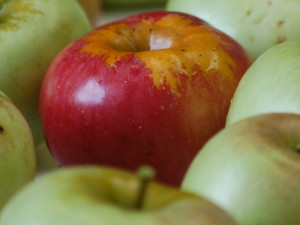 As I explain the characteristics of our apples at market, customers often ask what qualities differentiate an “eating” apple from a “cooking” apple. First, it is important to keep in mind that any variety of apple can be cooked and any variety of apple can be eaten fresh out of hand. What makes the difference is the customers’ expectations. This is the reason I always ask at market what the customer wants the apple to do. Do you want an apple that totally looses it shape when cooked? Do you want an apple that cooks tender but the slices stay whole and intact? Do you want to sauce it, make apple butter? Do you want to dry it or make dumplings? Do you want to keep it for long term storage? How YOU as the consumer want to use the apple should be the determining factor in choosing the variety of apple.
As I explain the characteristics of our apples at market, customers often ask what qualities differentiate an “eating” apple from a “cooking” apple. First, it is important to keep in mind that any variety of apple can be cooked and any variety of apple can be eaten fresh out of hand. What makes the difference is the customers’ expectations. This is the reason I always ask at market what the customer wants the apple to do. Do you want an apple that totally looses it shape when cooked? Do you want an apple that cooks tender but the slices stay whole and intact? Do you want to sauce it, make apple butter? Do you want to dry it or make dumplings? Do you want to keep it for long term storage? How YOU as the consumer want to use the apple should be the determining factor in choosing the variety of apple.
The produce industry has printed “self help” charts that try to answer the consumers’ questions about what apple variety to choose. I am no expert and my responses to my customers’ questions are strictly from my own personal experiences. I prefer to use a softer texture apple for making applesauce. Apples such as McIntosh, Cortland, Transparent, Lodi, Valstar are some of my favorites. I also like to use apples with tartness when I make sauce. The tartness of the apple is offset by my adding sugar. I am not usually an advocate of sugar, but Grandma’s applesauce needs to be sweet. I guess that is why the grandchildren clamor for my sauce. The only apple that I do not think makes a good pie or baked product is the Red Delicious. To me, I do not think this variety cooks tender. Again, strictly a matter of personal taste as the Red Delicious is the only apple my father wanted used in his pies. Everything but the Red Delicious, was just OK to him.
Solid, firm apple varieties are my recommendations for eating fresh. Sweet or tart really doesn’t make a great deal of difference. I like juicy apples and if the juice runs down my chin when I eat it, that’s even better. I am being honest and truthful when I say I do not think there is any apple that I do not care to eat fresh out of hand other than the Transparent and Lodi. When picking apples, it is not unusual for me to eat five or six. The job of the taster is certainly a difficult one!
This past week has been spent harvesting our Gingergold apples and this variety is a good example of versatility. The Gingergold, although developed for the fresh eating market, cooks very tender and makes a good apple to use in cooked products. The slice stays intact when baked and it makes good apple dumplings.
The next apple to be harvested at the orchard is the popular Gala. This apple is also versatile. It cooks tender but again the slice remains intact. The Gala is widely purchased, however, for its excellent fresh eating out of hand quality and flavor. The Gala is also very good to dry and makes great juice.
As different varieties ripen, I will try to elaborate on the characteristics of each one. When you come to market let me know what you want to do with the apple and I will try to point you to the right direction in making your choice. I really enjoy taking the time to help my customers. I think I have the best job in the whole world!
